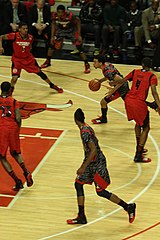| Revision as of 19:23, 22 February 2024 edit1ctinus (talk | contribs)Extended confirmed users, New page reviewers50,310 editsm Adding local short description: "Blocking move in team sports", overriding Wikidata description "blocking move by an offensive player in team sports"Tag: Shortdesc helper← Previous edit |
Latest revision as of 22:14, 5 November 2024 edit undoPol098 (talk | contribs)Extended confirmed users, Pending changes reviewers118,490 edits {{Refimprove|date=November 2024}} |
| (One intermediate revision by the same user not shown) |
| Line 1: |
Line 1: |
|
{{Short description|Blocking move in team sports}} |
|
{{Short description|Blocking move in team sports}} |
|
|
|
|
|
{{Refimprove|date=November 2024}} |
|
{{multiple image |
|
{{multiple image |
|
| align = right |
|
| align = right |
| Line 29: |
Line 31: |
|
}} |
|
}} |
|
|
|
|
|
A '''screen''' is a blocking move by an offensive player in which they stand beside or behind a defender in order to free up a teammate to either shoot, pass, or to drive in to score. In ] and ], it is also known as a ''']'''. Screens can be on-ball (when set for the ball-handler), or off-ball (when set for a teammate moving without the ball to get open for a pass). The two offensive players involved in setting the screen are known as the ''screener'' (who blocks the defender) and the ''cutter'' (who gets free from the defender). |
|
A '''screen''' in ]s is a blocking move by an offensive player in which they stand beside or behind a defender in order to free up a teammate to shoot, pass, or drive the ball in to score. In ] and ], it is also known as a ''']'''. Screens can be on-ball (when set for the ball-handler), or off-ball (when set for a teammate moving without the ball to get open for a pass). The two offensive players involved in setting the screen are known as the ''screener'' (who blocks the defender) and the ''cutter'' (who gets free from the defender). |
|
|
|
|
|
Successfully "setting a screen" in ] such as ] and ] requires attention to position and timing. An offensive player will first establish position so that his teammate can move toward him. The teammate changes pace and direction, and ''cuts'' (moves or dribbles quickly) very close to the screening player. The defender who is covering the cutter will have to push into the screening player, or divert around, losing a few steps. In basketball and lacrosse, the offensive player setting the pick must remain stationary at the moment of contact with the defender, and allow the defensive player a "reasonable opportunity" to avoid the screen; a screen is illegal if the screener moves in order to make contact, and obtains an advantage; the result is an offensive foul in basketball and a ] in lacrosse. There must be illegal contact for a moving screen to be a foul; no illegal contact, no foul, no matter how much moving the screener does. If the screener holds, leans or moves into the defender to cause contact, this will result in a foul on the screener. |
|
Successfully "setting a screen" in ] such as ] and ] requires attention to position and timing. An offensive player will first establish position so that a teammate can move toward them. The teammate changes pace and direction, and ''cuts'' (moves or dribbles quickly) very close to the screening player. The defender who is covering the cutter will have to push into the screening player, or divert around, losing a few steps. In basketball and lacrosse, the offensive player setting the pick must remain stationary at the moment of contact with the defender, and allow the defensive player a "reasonable opportunity" to avoid the screen; a screen is illegal if the screener moves in order to make contact, and obtains an advantage; the result is an offensive foul in basketball and a ] in lacrosse. There must be illegal contact for a moving screen to be a foul; no illegal contact, no foul, no matter how much moving the screener does. If the screener holds, leans or moves into the defender to cause contact, this will result in a foul on the screener. |
|
|
|
|
|
] and ] for Chris Walker at the ].]] |
|
] and ] for Chris Walker at the ].]] |
After setting the screen, the screener is often open to roll to the basket and receive a pass. This tactic is called pick and roll in basketball. Another basketball tactic, called the pick and pop, is for the ballhandler to drive to the basket while the screener squares for a jumpshot.
Defensive moves to defeat a screen include sliding by the pick if the screening player leaves space, fighting over the screen (pushing the screener away, where allowed—this is not allowed in basketball), if the defender is strong enough, or switching defensive assignments with another defender, who can pick up the cutter on the other side of the screen.


 After Jarell Martin sets a pick on Cat Barber for Nigel Williams-Goss, that breaks Williams-Goss free for a drive down the lane at the 2013 McDonald's All-American Boys Game
After Jarell Martin sets a pick on Cat Barber for Nigel Williams-Goss, that breaks Williams-Goss free for a drive down the lane at the 2013 McDonald's All-American Boys Game

